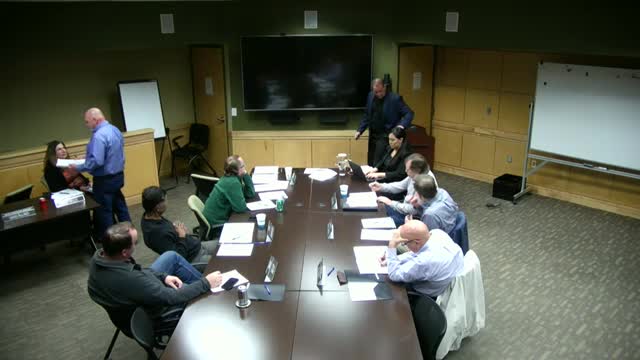Commission hears water‑resource and operations update: groundwater down, CAP use up, wheeling capacity expanded
January 13, 2025 | Oro Valley, Pima County, Arizona
This article was created by AI summarizing key points discussed. AI makes mistakes, so for full details and context, please refer to the video of the full meeting. Please report any errors so we can fix them. Report an error »

Staff reported Jan. 13 that Oro Valley’s water resource mix shifted in 2024 toward greater use of CAP water and lower groundwater pumping, and that the utility is pursuing multiple delivery pathways to increase reliability.
Peter (water utility staff) told the commission that the utility’s three sources of supply are groundwater, CAP water and reclaimed water. Staff said groundwater production was at near historic lows in 2024 while CAP deliveries were near historic highs; reclaimed production was largely steady year to year. The utility’s CAP allocation was cited as 10,305 acre‑feet, and staff noted the utility is currently delivering only a fraction of that allocation because of downstream delivery constraints and system capacity limits with Tucson Water’s wheeling arrangements.
Staff described a completed upgrade to the Countryside wheeling station capacity (working with Tucson Water) that raised base wheeling capacity from about 100 gallons per minute to about 300 gallons per minute; staff said the project was offline for part of 2024 for the upgrade and that a full year of service in 2025 should show reduced groundwater pumping there.
On regional supply planning, Peter described the Northwest Recharge Recovery Delivery System (NWRRDS) partnership among Oro Valley, Metro Water and Marana as a response to capacity limits inside Tucson Water’s system and as a diversification strategy. Staff said they expect to maintain wheeling arrangements with Tucson Water in parallel with partner projects because wheeling remains valuable to deliver CAP water into parts of Oro Valley that a local recharge/recovery project cannot reach directly.
Operations update: staff summarized core system responsibilities (24/7 SCADA monitoring, reclaimed and potable system operation, meter and AMI program work). Staff also described a multiyear program to replace field programmable logic controllers (PLCs) and vertical turbine pumps at the reclaimed booster plant. A meter change‑out program of roughly 2,400 meters and smart points was underway; staff said the replacement would be delivered through the meter manufacturer and a contractor at no cost to the utility under warranty arrangements for initial replacements, with the utility budgeting to take over replacements in future years.
Commissioners asked whether the utility is taking its full CAP allocation (the reply was that the utility is not using the full 10,305‑acre‑foot allocation and that wheeling capacity constraints and system delivery limits are the main reason). Staff said diversifying delivery (wheeling + recharge/recovery) was the least‑cost path compared with extensive upgrades inside Tucson Water’s system.
No formal action was taken on resource or operations items; commissioners received the report and asked staff to continue tracking CAP deliveries, wheeling capacity and the distributional effects of the meter change‑out program.
Peter (water utility staff) told the commission that the utility’s three sources of supply are groundwater, CAP water and reclaimed water. Staff said groundwater production was at near historic lows in 2024 while CAP deliveries were near historic highs; reclaimed production was largely steady year to year. The utility’s CAP allocation was cited as 10,305 acre‑feet, and staff noted the utility is currently delivering only a fraction of that allocation because of downstream delivery constraints and system capacity limits with Tucson Water’s wheeling arrangements.
Staff described a completed upgrade to the Countryside wheeling station capacity (working with Tucson Water) that raised base wheeling capacity from about 100 gallons per minute to about 300 gallons per minute; staff said the project was offline for part of 2024 for the upgrade and that a full year of service in 2025 should show reduced groundwater pumping there.
On regional supply planning, Peter described the Northwest Recharge Recovery Delivery System (NWRRDS) partnership among Oro Valley, Metro Water and Marana as a response to capacity limits inside Tucson Water’s system and as a diversification strategy. Staff said they expect to maintain wheeling arrangements with Tucson Water in parallel with partner projects because wheeling remains valuable to deliver CAP water into parts of Oro Valley that a local recharge/recovery project cannot reach directly.
Operations update: staff summarized core system responsibilities (24/7 SCADA monitoring, reclaimed and potable system operation, meter and AMI program work). Staff also described a multiyear program to replace field programmable logic controllers (PLCs) and vertical turbine pumps at the reclaimed booster plant. A meter change‑out program of roughly 2,400 meters and smart points was underway; staff said the replacement would be delivered through the meter manufacturer and a contractor at no cost to the utility under warranty arrangements for initial replacements, with the utility budgeting to take over replacements in future years.
Commissioners asked whether the utility is taking its full CAP allocation (the reply was that the utility is not using the full 10,305‑acre‑foot allocation and that wheeling capacity constraints and system delivery limits are the main reason). Staff said diversifying delivery (wheeling + recharge/recovery) was the least‑cost path compared with extensive upgrades inside Tucson Water’s system.
No formal action was taken on resource or operations items; commissioners received the report and asked staff to continue tracking CAP deliveries, wheeling capacity and the distributional effects of the meter change‑out program.
View full meeting
This article is based on a recent meeting—watch the full video and explore the complete transcript for deeper insights into the discussion.
View full meeting
